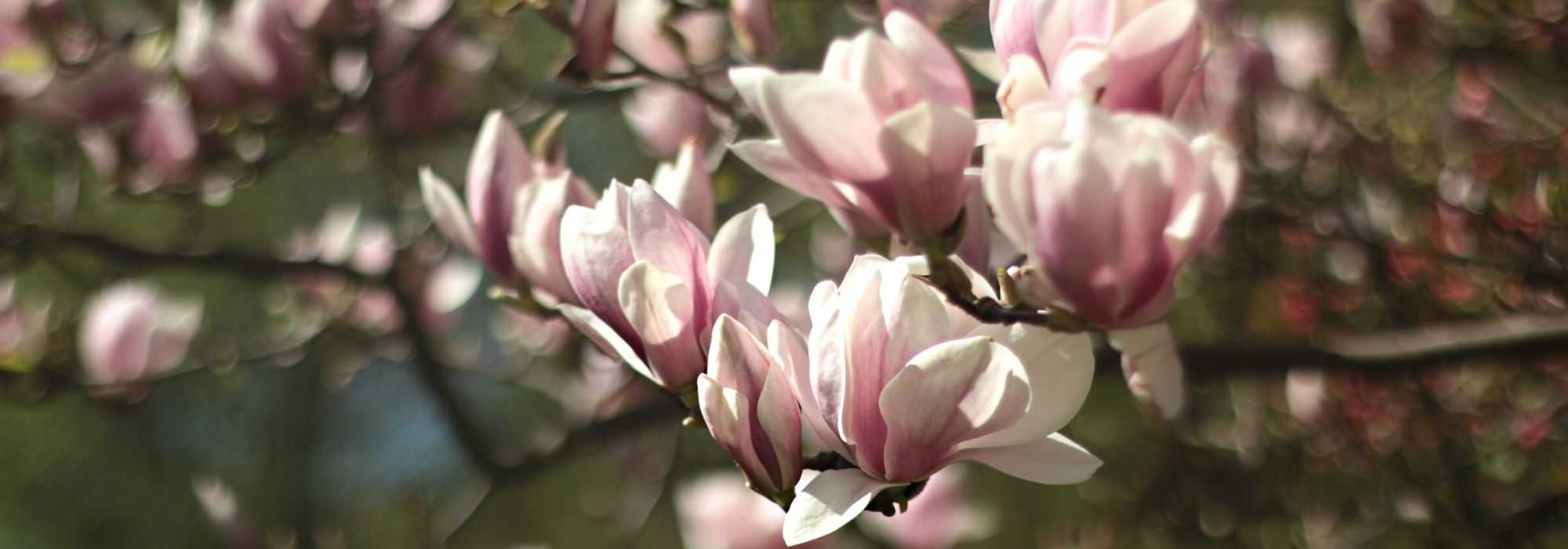
Magnolia: choose the variety suited to your garden
Our advice
Contents
How can you resist the beauty of large-flowered magnolias, dazzling during their flowering? These trees with spectacular flowers, among the largest found in the vegetable kingdom, rank among the oldest known. Treated as trees or bushes depending on their size, which varies from 3 m to over 10 m, they are particularly ornamental, flower generously and prove very easy to live with once established in the garden. Often grown as coppice shoots (trunk ramified at the base), they offer the garden incomparable grace and a very attractive appearance. Deciduous or evergreen, scented or unscented, they suit a wide range of situations.
But, with around 130 botanical species and ever more numerous hybrids, choosing one is difficult when you have decided to plant one! One might think that only the colour and shape of their large flowers set them apart. That’s not entirely true, since new magnolia varieties display specific traits that allow them to adapt to different situations.
Follow our advice to find which magnolia(s) will best enhance your garden!
Based on foliage: evergreen or deciduous
There are two main categories of magnolias:
- deciduous magnolias originating from Asia (China and Japan), which flower in spring,
- Magnolia grandiflora or tulip magnolias, also called large-flowered magnolias, evergreen, originate from the south-eastern United States and flower in summer.
Deciduous magnolias have the particularity of flowering on naked wood, which particularly showcases their large flowers in pink, white or, more rarely, yellow. This flowering occurs from March through June and even July. If you want to give your garden a superb spring display that lasts several weeks, a magnolia soulangeana or stellata will be most effective. These bushes are superb planted alone or in a mass planting. Some deciduous species, such as magnolia tripelata, however offer luxuriant foliage that is their main asset.
The different varieties of evergreen magnolias, Magnolia grandiflora, give by their gigantic foliage a very interesting exotic aspect in a garden. They are among the few trees with evergreen leaves, and thanks to their glossy dark green foliage provide a distinctive year-round feature. Their slow growth during the first years makes them attractive bushes. They are perfectly suited to planting alone on a short grass meadow, such as magnolia grandiflora Alta with narrow habit or magnolia grandiflora Galissonière.
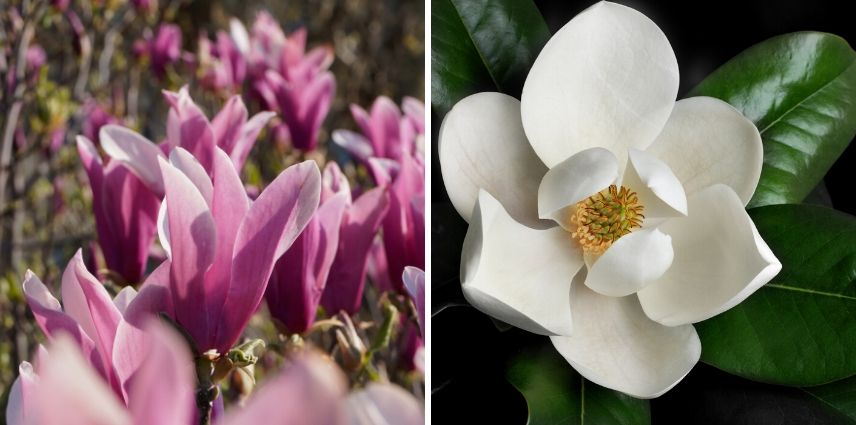
Magnolia liliflora ‘Nigra’ (deciduous foliage) and Magnolia grandiflora (evergreen foliage)
Read also
Magnolias: planting, pruning and careDepending on flowering period: spring or summer
Two main flowering periods for magnolias are spring and summer, with some differences depending on species, and sometimes timid repeat flowering in autumn.
Spring flowering spans from March for earliest varieties to early July. Chosen bushes need a particularly sheltered position to protect downy floral buds sensitive to late-winter frosts and winds.
Among early flowerings from March, Magnolia soulangeana ‘Heavy Scent’, with pink tulip-shaped flowers, has the advantage of flowering very young, from 3 years. The Magnolia loebneri ‘Merrill’ has very delicate pink star-shaped flowers. The Magnolia ‘Fairy White’ – Michelia hybrid is a new introduction, a rare bush because of its delicately scented white spring flowering and evergreen foliage.
Later magnolias tolerate cold climates better, such as Magnolia sieboldii, whose flowers open from May to July. The original Magnolia brooklynensis ‘Eva Maria’ will also flower from May on already leafy branches, offering a stunning display of cup-shaped flowers whose colour changes as flowering progresses.
If summer flowering, generally very fragrant, appeals most to you, Magnolias grandiflora such as Magnolia ‘Alta’ or Magnolia delavayi, with large cream flowers 10 to 20 cm and a lemon-scented fragrance, will be superb garden companions.
→ See also: 5 Magnolias that flower in summer and 5 Magnolias that flower in spring

Magnolia loebneri ‘Merrill’, Magnolia sieboldii and Magnolia delavayii
Discover other Magnolia
View all →Available in 0 sizes
Available in 1 sizes
Available in 1 sizes
Available in 2 sizes
Available in 1 sizes
Available in 1 sizes
Available in 1 sizes
Available in 3 sizes
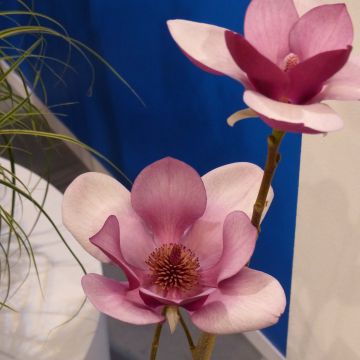
Available in 1 sizes
Available in 1 sizes
Depending on pruning: for a small or large garden
Magnolias are often large (some reach up to 15 m tall) and become trees as they age. However, most are bush varieties and are often treated as bushes, because their growth is slow. Their dimensions are mostly between 2.50 and 5 m in height, so they adapt very well to small and medium gardens. They can even be planted close to a house or a terrace, their superficial roots not being problematic for foundations or services.
For small gardens
Stellata magnolias, with delightful star-shaped flowers, generally white, remain compact and are well suited to the small spaces they enhance. The Magnolia stellata ‘Gold Star’, with pale yellow flowers appearing from April to May, is very well suited by its modest development (3 m in all directions) to a small garden. Magnolia ‘liliflora nigra’, with cup-shaped pink flowers, also deciduous and of compact dimensions (2 m in height and spread), is likewise a good subject for a small space. One might even consider a dwarf, evergreen magnolia that flowers in summer such as grandiflora ‘Little Gem’, with superb fragrant cream-coloured inflorescences, its small size (2.50 m) allowing it to occupy reduced spaces.
→ Read also: 7 magnolias for small gardens
For large gardens
If you have a large space, don’t hesitate to choose a Magnolia grandiflora. Although they can reach 20 m tall in their native habitat, in our latitudes they behave as bushes for many years. Their summer flowering is certainly more discreet than that of deciduous magnolias, but the multitude of new cultivars offers incredible foliage. This species is very interesting for the exotic effect created by its large leaves.
Another possible choice, the Magnolia obovata, deciduous, measuring 10 m tall, will charm you with its very large foliage and cream-coloured flowering in late spring.
Finally, the Kobé magnolia (Magnolia kobus), native to Japan, with superb white flowers, brings a rare elegance to a large short grass meadow, but be aware that this 10 m tall tree does not flower before about ten years.
→ Read also: 7 majestic magnolias for large gardens.
Depending on its hardiness
Because of their Asian and American origins, magnolias are not very frost-tender. They withstand temperatures down to -15°C. They can therefore be planted almost anywhere in France, except at altitude in mountain regions that are too cold.
However, for flowering of deciduous varieties that occurs between March and April, the fragile downy floral buds are sensitive to cold and frost. Even if the tree tolerates very low temperatures, in the coldest regions it is advisable to choose late varieties, flowering from May onwards, for example Magnolia sieboldii with its charming bell-shaped flowers with red centres, or a Magnolia hypoleuca (obovata), striking for its large leaves and the beauty of its white flowers, hardy down to -20°C.
In any case, bear in mind that you should place your magnolia in a sheltered spot protected from wind.
By flower shape
If colours are mainly white, cream, sugared-almond pink through to purple and yellow and will no doubt form part of your aesthetic choices, the very varied forms contribute greatly to magnolia originality: solitary flowers in upright cup- or goblet-shapes, star-shaped, slender or rounded flowers, trailing flowers — effect varies greatly but is always extremely graceful.
Do you fall for large fleshy tulip-shaped flowers? Magnolias soulangeana and grandiflora, identifiable by their beautiful cup-shaped calyx and numerous stamens, are made for you. If you appreciate delicacy of more slender, star-shaped flowers, lily-flowered magnolias (liliiflora), Magnolias stellata and loebneri, with petals (actually tepals) slightly incurved at the tips, will suit you well. Finally, if originality appeals, Magnolia sieboldii, with its trailing bell-shaped flowers and delightful lemon scent, will bring a very fresh, bi-coloured note with its deep crimson centre.

Several types of flowers: Magnolia soulangeana, Magnolia stellata and Magnolia sieboldii
Depending on your soil
Magnolias thrive in rich, cool to moist, well-drained soils. Plant in neutral to acidic soil, as they dislike calcareous conditions.
Some exceptions to this rule: the majestic Magnolia kobus (or Kobé magnolia) tolerates calcareous soil. The Magnolia x loebneri ‘Leonard Messei’ tolerates slightly alkaline soils. The Magnolia denudata, encountered somewhat less often, can also develop in slightly acidic soil provided it remains cool and humic.
Magnolia grandiflora tolerates calcareous soil and, unusually among magnolias, rather dry conditions.
Finally, magnolia roots remain superficial, in top layer of soil: take care when planting, ideally in spring.
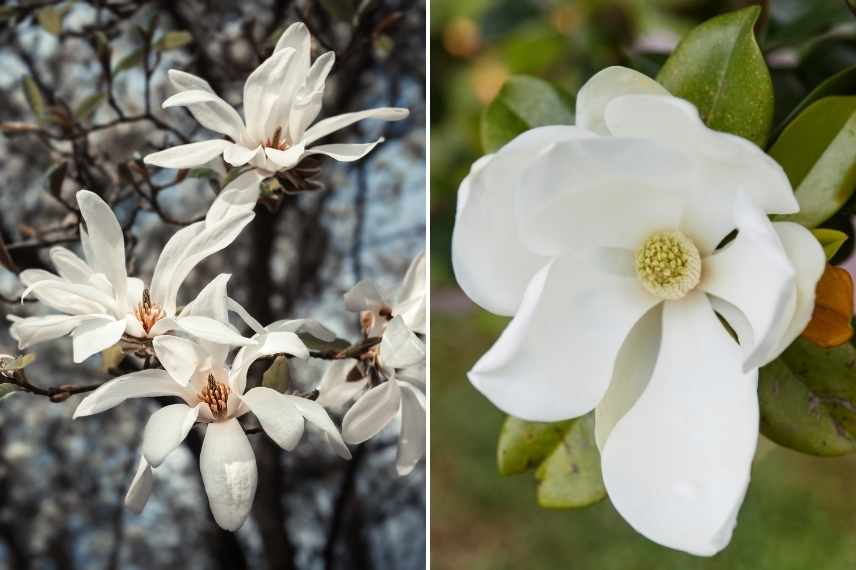
Kobé and grandiflora magnolias can tolerate slightly calcareous soil
- Subscribe!
- Contents
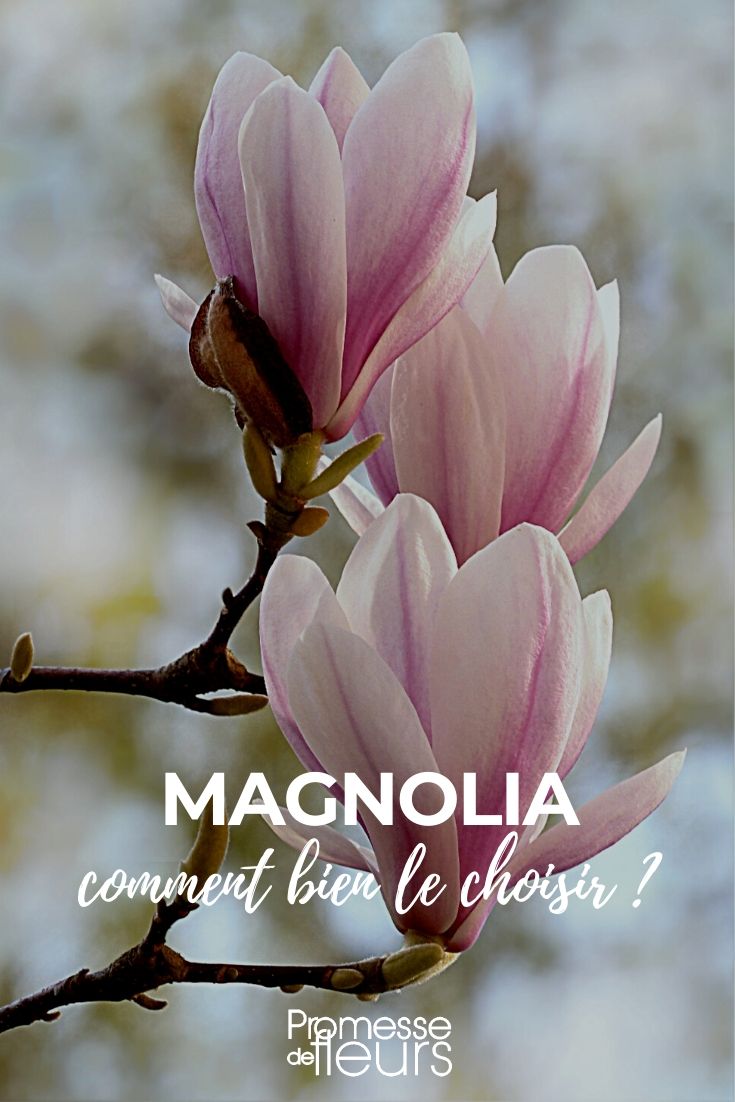

































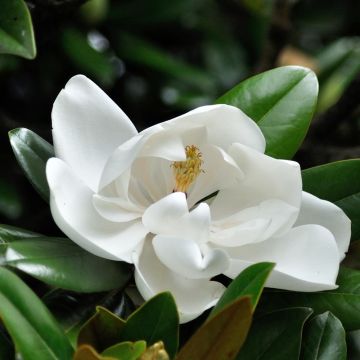
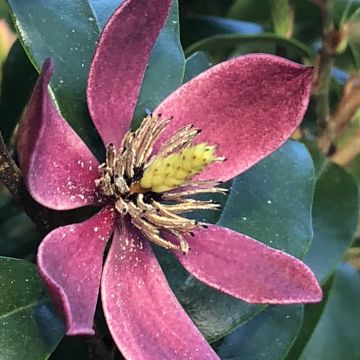
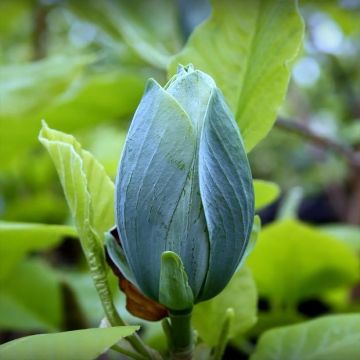
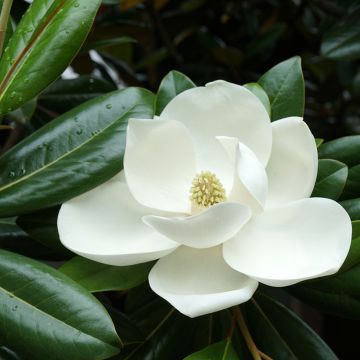
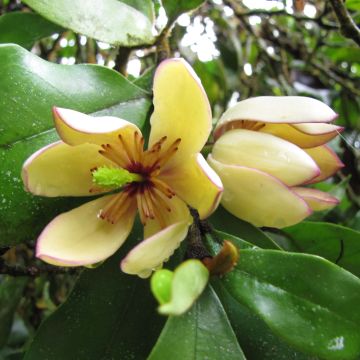
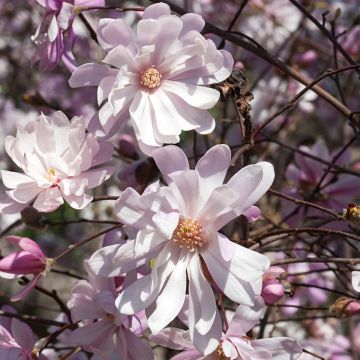
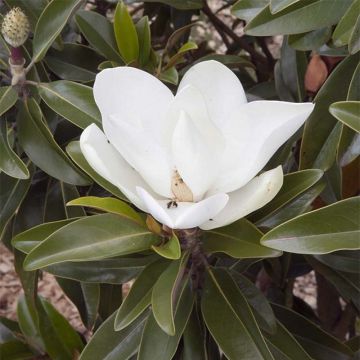
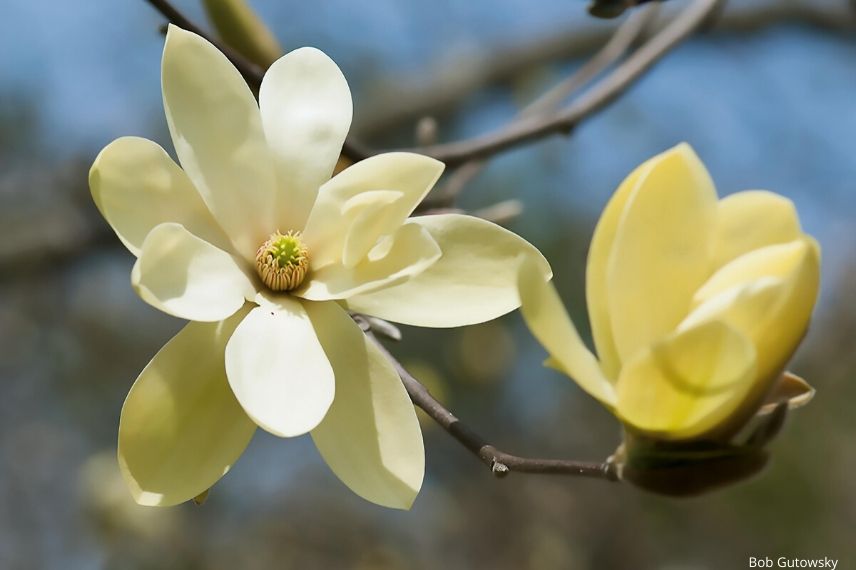
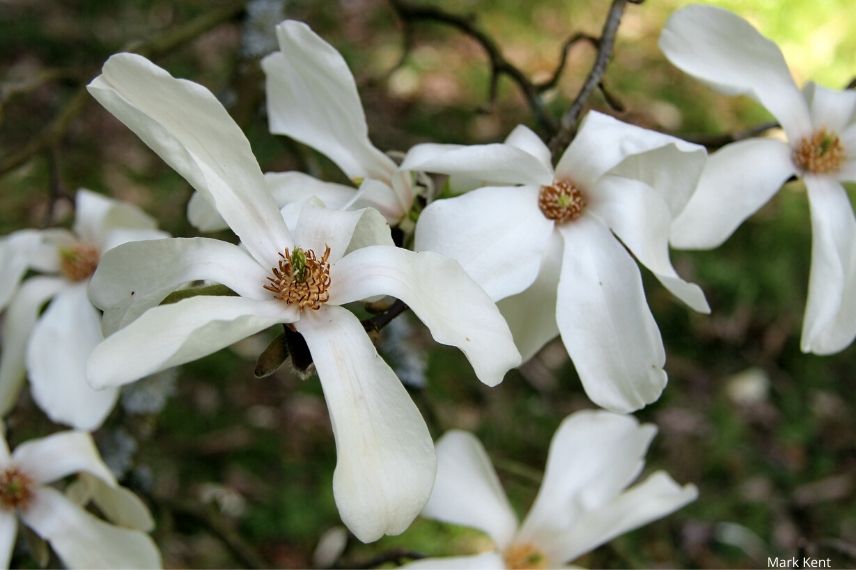
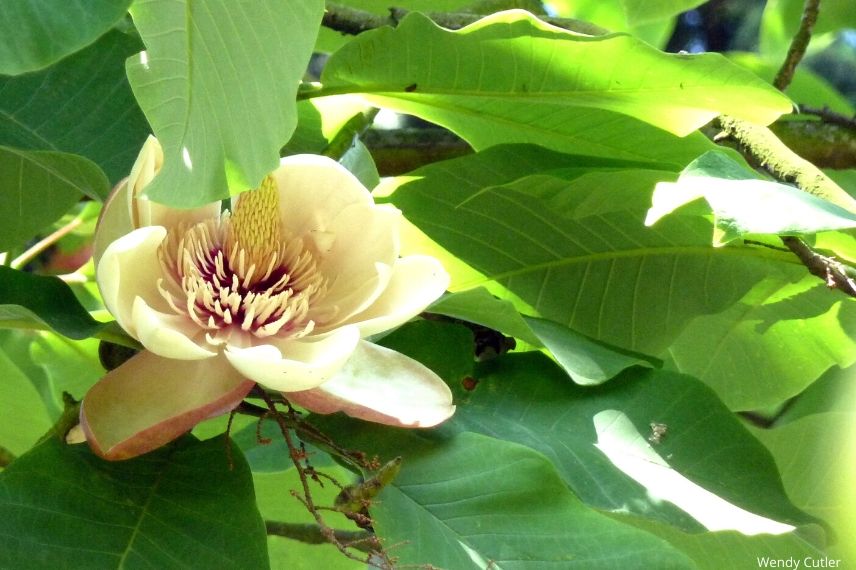
Comments